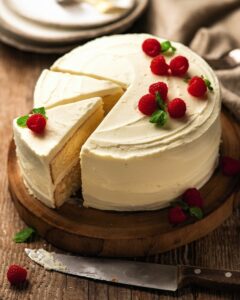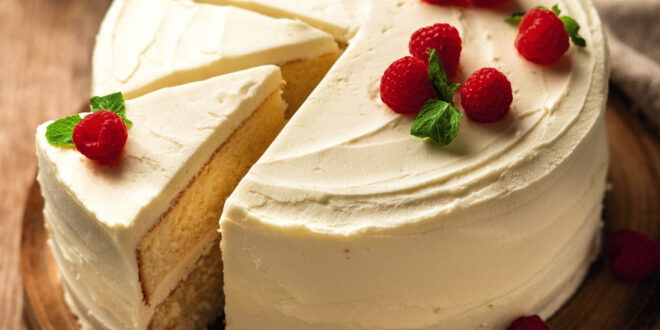Recipe courtesy of Dinner by Nagi Maehashi, Macmillan Publishers, RRP $49.99
‘Plush’ is the best word to describe this gorgeous cake!
This recipe has rocketed into the top 10 on my website since I published it two years ago and has stayed there ever since!
It’s a classic vanilla butter cake but with Japanese techniques applied to produce the moistest and softest cake you’ve ever eaten. It’s a true professional bakery-quality cake, which also stays fresh for 4 days – unheard of! This cake is the ultimate blank canvas for your cake-making imagination: from layer cakes to birthday cakes, Victoria sponge to strawberry shortcake … the possibilities are endless!
Serves: 12 | prep: 20 minutes + 15 minutes cooling | cook: 35 minutes
 Ingredients
Ingredients
BATTER
- 2 cups (300 g) plain flour1
- 2 1⁄2 tsp baking powder2
- 1⁄4 tsp cooking salt*
- 4 large eggs*, at room temperature
- 1 1⁄2 cups (300 g) caster sugar3
- 115 g unsalted butter, cut into 1.5 cm cubes
- 1 cup (250 ml) full-fat milk
- 3 tsp vanilla extract4
- 3 tsp canola oil5
Frosting – See below
Preheat the oven to 180°C (160°C fan-forced) for 20 minutes before starting the batter. Place the shelf in the middle of the oven. Grease two 20 cm6 cake tins with butter, then line with baking paper.
Dry ingredients – Whisk the flour, baking powder and salt in a large bowl. Set aside.
Fluff eggs – Beat the eggs for 30 seconds on medium–high (speed 6 of 10) in a stand mixer fitted with the whisk attachment, or use hand-held electric beaters. With the beaters still going, slowly pour the sugar in over 45 seconds, then beat for 7 minutes on high (speed 8), or until tripled in volume and white in colour.
Heat butter and milk – While the egg is beating, place the butter and milk in a heatproof jug and microwave for 2 minutes on High to melt the butter (or use the stove). Do not let the milk bubble and boil (foaming is okay).
Add dry ingredients – When the egg is whipped, scatter one-third of the flour mixture across the surface, then beat on speed 1 for 5 seconds. Add half the remaining flour mixture, then mix again for 5 seconds. Add the remaining flour, then mix for 5–10 seconds until the flour is just mixed in. Once you can’t see any flour, stop straight away.
Hot milk mixture – Pour the hot milk mixture, vanilla and oil into the now-empty flour bowl. Add about 1 1⁄2 cups of the egg mixture (no need to be exact) into the hot milk mixture, then use a whisk to mix until smooth – you can be vigorous. It will be foamy.
Combine batter – Turn the beaters back on to the lowest speed (speed 1), then slowly pour the hot milk mixture back into the egg mixture over 15 seconds, then turn the beaters off.
Finish batter – Scrape down the side and base of the bowl and beat on speed 1 for 10 seconds – the batter should now be smooth and pourable.
Bake – Pour the batter into the prepared tins. Bang each cake tin on the counter three times to knock out any large bubbles. Bake for 30 minutes or until golden and a toothpick inserted into the centre of the cake comes out clean.
Cool – Remove the cakes from the oven. Cool in the tins for 15 minutes, then gently turn out onto wire racks. If using as layer cakes, cool upside down – the slight dome will flatten perfectly. Level cake = neat layers.
Decorate and serve – Decorate with the frosting of your choice (see recipe below), or cream and fresh berries or jam. Though honestly, the cake is so moist, you can eat it plain!
NOTES
- Cake flour also works fine but it doesn’t improve the texture or shelf life so it’s unnecessary!
- Dead baking powder is a common baking fail – expiry dates on jars are misleading! See Baking powder testing in the Glossary (page 357).
- Normal white sugar works fine too, but you may get some tiny brown spots on the base (larger grains don’t dissolve as well).
- Use the best vanilla extract you can afford, for great vanilla flavour. Give imitation vanilla essence a miss.
- Or vegetable or grapeseed oil, or other neutral-flavoured oil.
- It’s best to use a tin without a loose base as the batter is quite thin so there may be slight leakage. If you only have a springform tin, plug the crack with softened butter. Other cake tin sizes: three 20 cm cake tins – 23 minutes; two 23 cm cake tins – 27 minutes; three 23 cm cake tins – 20 minutes; two 15 cm cake tins – halve the recipe, 25 minutes’ bake time; 12 cup (3 litre) bundt tin (grease and dust with flour) – bake 1 hour; 23 x 33 cm rectangular tin – 30 minutes.For cupcakes, halve the batch of batter, line a 12-hole muffin tin with cupcake liners. Fill the holes two-thirds of the way (no more) and bake for 22 minutes.
LEFTOVERS Store unfrosted cake in an airtight container in a cool pantry. It will stay near fresh for 5 days, which is a special feature of this cake! Or freeze for 3 months. If decorated with cream or buttercream-based frosting it should be kept in the fridge. Always bring the cake to room temperature before serving!
Vanilla Frosting
- 250 g unsalted butter*, at room temperature1
- 4 cups (500 g) soft icing sugar*, sifted
- 3 tsp vanilla extract
- 1⁄8 tsp table salt*
- 1-2 tbsp milk, as needed
Cream butter – Beat the butter in a stand mixer fitted with the paddle attachment, or with hand-held electric beaters, for 3 minutes on the highest speed until it changes from yellow to almost white, scraping down the bowl once or twice. The butter should be smooth and creamy.
Icing sugar – Add the icing sugar in three lots. Start beating slowly (to avoid a powder storm), then increase speed gradually. With each addition, once the icing sugar is mostly incorporated, add more icing sugar and repeat. When all the icing sugar has been added, beat on high for a full 3 minutes until fluffy.
Flavour it! – Add the vanilla, salt and milk, then beat for a further 30 seconds or until incorporated. If the buttercream is too thick, use milk to make it soft and creamy but it should still hold its form for piping. If it’s too loose, use extra icing sugar to thicken.
Frost – Use the frosting immediately!
NOTES
- The butter should be soft enough that a dent remains when touched with your finger but not so soft that it leaves a shiny slick of grease on your finger. If you want to get technical, the temperature should be 17°C! If it is too soft, your buttercream may end up too sloppy. See Butter in the Glossary (page 357) for a fast, reliable way to soften fridge-cold butter.
- Make ahead: The frosting can be made up to 2 days ahead. Keep in the fridge with plastic wrap touching the surface (to prevent a crust forming). Bring to room temperature, then beat on high speed for 1–2 minutes to make it fluffy and creamy again.
LEFTOVERS Buttercream needs to be used immediately. Frosted cakes and cupcakes should be kept in the fridge. But always bring to room temperature before eating because buttercream goes hard in the fridge – it should be soft and creamy!










Join the Discussion
Type out your comment here:
You must be logged in to post a comment.